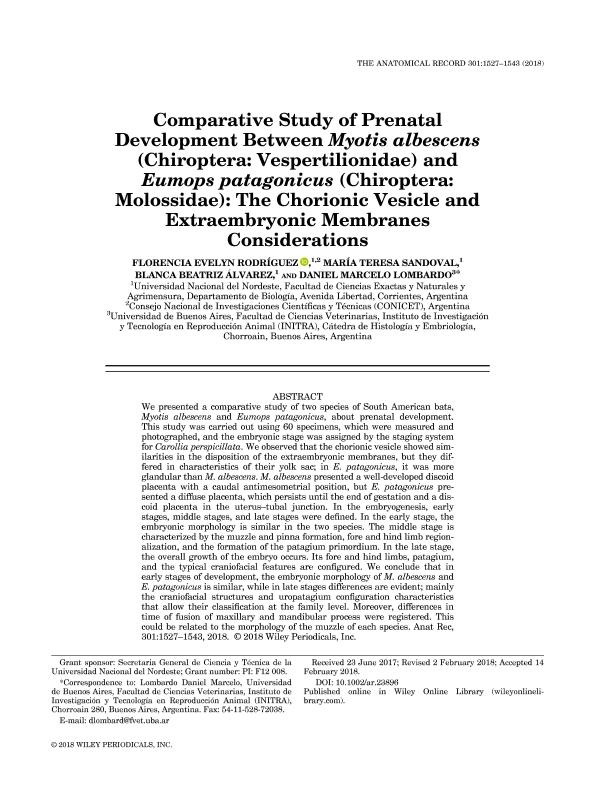Artículo
Comparative study of prenatal development between myotis albescens (chiroptera: vespertilionidae) and eumops patagonicus (chiroptera: molossidae): the chorionic vesicle and extraembryonic membranes considerations
Rodriguez, Florencia Evelyn ; Sandoval, María Teresa; Alvarez de Avanza, Blanca Beatriz; Lombardo, Daniel Marcelo
; Sandoval, María Teresa; Alvarez de Avanza, Blanca Beatriz; Lombardo, Daniel Marcelo
 ; Sandoval, María Teresa; Alvarez de Avanza, Blanca Beatriz; Lombardo, Daniel Marcelo
; Sandoval, María Teresa; Alvarez de Avanza, Blanca Beatriz; Lombardo, Daniel Marcelo
Fecha de publicación:
09/2018
Editorial:
Veterinary and Human Toxicology
Revista:
Anatomical Record-Advances in Integrative Anatomy and Evolutionary Biology
ISSN:
1932-8494
e-ISSN:
1932-8486
Idioma:
Inglés
Tipo de recurso:
Artículo publicado
Clasificación temática:
Resumen
We presented a comparative study of two species of South American bats, Myotis albescens and Eumops patagonicus, about prenatal development. This study was carried out using 60 specimens, which were measured and photographed, and the embryonic stage was assigned by the staging system for Carollia perspicillata. We observed that the chorionic vesicle showed similarities in the disposition of the extraembryonic membranes, but they differed in characteristics of their yolk sac; in E. patagonicus, it was more glandular than M. albescens. M. albescens presented a well-developed discoid placenta with a caudal antimesometrial position, but E. patagonicus presented a diffuse placenta, which persists until the end of gestation and a discoid placenta in the uterus–tubal junction. In the embryogenesis, early stages, middle stages, and late stages were defined. In the early stage, the embryonic morphology is similar in the two species. The middle stage is characterized by the muzzle and pinna formation, fore and hind limb regionalization, and the formation of the patagium primordium. In the late stage, the overall growth of the embryo occurs. Its fore and hind limbs, patagium, and the typical craniofacial features are configured. We conclude that in early stages of development, the embryonic morphology of M. albescens and E. patagonicus is similar, while in late stages differences are evident; mainly the craniofacial structures and uropatagium configuration characteristics that allow their classification at the family level. Moreover, differences in time of fusion of maxillary and mandibular process were registered. This could be related to the morphology of the muzzle of each species.
Archivos asociados
Licencia
Identificadores
Colecciones
Articulos(CCT - NORDESTE)
Articulos de CTRO.CIENTIFICO TECNOL.CONICET - NORDESTE
Articulos de CTRO.CIENTIFICO TECNOL.CONICET - NORDESTE
Citación
Rodriguez, Florencia Evelyn; Sandoval, María Teresa; Alvarez de Avanza, Blanca Beatriz; Lombardo, Daniel Marcelo; Comparative study of prenatal development between myotis albescens (chiroptera: vespertilionidae) and eumops patagonicus (chiroptera: molossidae): the chorionic vesicle and extraembryonic membranes considerations; Veterinary and Human Toxicology; Anatomical Record-Advances in Integrative Anatomy and Evolutionary Biology; 301; 9; 9-2018; 1527-1543
Compartir
Altmétricas



